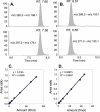Distribution of DNA adducts caused by inhaled formaldehyde is consistent with induction of nasal carcinoma but not leukemia
- PMID: 20176625
- PMCID: PMC2905397
- DOI: 10.1093/toxsci/kfq061
Distribution of DNA adducts caused by inhaled formaldehyde is consistent with induction of nasal carcinoma but not leukemia
Abstract
Inhaled formaldehyde is classified as a known human and animal carcinogen, causing nasopharyngeal cancer. Additionally, limited epidemiological evidence for leukemia in humans is available; however, this is inconsistent across studies. Both genotoxicity and cytotoxicity are key events in formaldehyde nasal carcinogenicity in rats, but mechanistic data for leukemia are not well established. Formation of DNA adducts is a key event in initiating carcinogenesis. Formaldehyde can induce DNA monoadducts, DNA-DNA cross-links, and DNA protein cross-links. In this study, highly sensitive liquid chromatography-tandem mass spectrometry-selected reaction monitoringmethods were developed and [(13)CD(2)]-formaldehyde exposures utilized, allowing differentiation of DNA adducts and DNA-DNA cross-links originating from endogenous and inhalation-derived formaldehyde exposure. The results show that exogenous formaldehyde induced N(2)-hydroxymethyl-dG monoadducts and dG-dG cross-links in DNA from rat respiratory nasal mucosa but did not form [(13)CD(2)]-adducts in sites remote to the portal of entry, even when five times more DNA was analyzed. Furthermore, no N(6)-HO(13)CD(2)-dA adducts were detected in nasal DNA. In contrast, high amounts of endogenous formaldehyde dG and dA monoadducts were present in all tissues examined. The number of exogenous N(2)-HO(13)CD(2)-dG in 1- and 5-day nasal DNA samples from rats exposed to 10-ppm [(13)CD(2)]-formaldehyde was 1.28 +/- 0.49 and 2.43 +/- 0.78 adducts/10(7) dG, respectively, while 2.63 +/- 0.73 and 2.84 +/- 1.13 N(2)-HOCH(2)-dG adducts/10(7) dG and 3.95 +/- 0.26 and 3.61 +/- 0.95 N(6)-HOCH(2)-dA endogenous adducts/10(7) dA were present. This study provides strong evidence supporting a genotoxic and cytotoxic mode of action for the carcinogenesis of inhaled formaldehyde in respiratory nasal epithelium but does not support the biological plausibility that inhaled formaldehyde also causes leukemia.
Figures







Comment in
-
Considerations for the implausibility of leukemia induction by formaldehyde.Toxicol Sci. 2011 Mar;120(1):230-2; author reply 233. doi: 10.1093/toxsci/kfq340. Epub 2010 Nov 8. Toxicol Sci. 2011. PMID: 21059796 No abstract available.
Similar articles
-
Molecular dosimetry of N2-hydroxymethyl-dG DNA adducts in rats exposed to formaldehyde.Chem Res Toxicol. 2011 Feb 18;24(2):159-61. doi: 10.1021/tx1003886. Epub 2010 Dec 14. Chem Res Toxicol. 2011. PMID: 21155545 Free PMC article.
-
Evaluation of inhaled low-dose formaldehyde-induced DNA adducts and DNA-protein cross-links by liquid chromatography-tandem mass spectrometry.Arch Toxicol. 2019 Mar;93(3):763-773. doi: 10.1007/s00204-019-02393-x. Epub 2019 Jan 30. Arch Toxicol. 2019. PMID: 30701286 Free PMC article.
-
Determination of N2-hydroxymethyl-dG adducts in the nasal epithelium and bone marrow of nonhuman primates following 13CD2-formaldehyde inhalation exposure.Chem Res Toxicol. 2011 Feb 18;24(2):162-4. doi: 10.1021/tx1004166. Epub 2011 Jan 11. Chem Res Toxicol. 2011. PMID: 21222454 Free PMC article.
-
The implausibility of leukemia induction by formaldehyde: a critical review of the biological evidence on distant-site toxicity.Regul Toxicol Pharmacol. 2004 Oct;40(2):92-106. doi: 10.1016/j.yrtph.2004.05.001. Regul Toxicol Pharmacol. 2004. PMID: 15450713 Review.
-
An updated mode of action and human relevance framework evaluation for Formaldehyde-Related nasal tumors.Crit Rev Toxicol. 2020 Nov;50(10):919-952. doi: 10.1080/10408444.2020.1854679. Crit Rev Toxicol. 2020. PMID: 33599198 Review.
Cited by
-
Formation of hydroxymethyl DNA adducts in rats orally exposed to stable isotope labeled methanol.Toxicol Sci. 2012 Mar;126(1):28-38. doi: 10.1093/toxsci/kfr328. Epub 2011 Dec 8. Toxicol Sci. 2012. PMID: 22157354 Free PMC article.
-
Comparitive efficacies of a natural fixative with a conventional fixative.J Oral Maxillofac Pathol. 2017 Sep-Dec;21(3):458. doi: 10.4103/jomfp.JOMFP_236_15. J Oral Maxillofac Pathol. 2017. PMID: 29391731 Free PMC article.
-
Natural Alternatives for Chemicals Used in Histopathology Lab- A Literature Review.J Clin Diagn Res. 2016 Nov;10(11):EE01-EE04. doi: 10.7860/JCDR/2016/23420.8860. Epub 2016 Nov 1. J Clin Diagn Res. 2016. PMID: 28050388 Free PMC article. Review.
-
Identifying the Reactive Metabolites of Tyrosine Kinase Inhibitor Pexidartinib In Vitro Using LC-MS-Based Metabolomic Approaches.Chem Res Toxicol. 2023 Aug 21;36(8):1427-1438. doi: 10.1021/acs.chemrestox.3c00164. Epub 2023 Aug 2. Chem Res Toxicol. 2023. PMID: 37531179 Free PMC article.
-
Mode of action-based risk assessment of genotoxic carcinogens.Arch Toxicol. 2020 Jun;94(6):1787-1877. doi: 10.1007/s00204-020-02733-2. Epub 2020 Jun 15. Arch Toxicol. 2020. PMID: 32542409 Free PMC article. Review.
References
-
- Casanova M, Morgan KT, Gross EA, Moss OR, Heck HA. DNA-protein cross-links and cell replication at specific sites in the nose of F344 rats exposed subchronically to formaldehyde. Fundam. Appl. Toxicol. 1994;23:525–536. - PubMed
-
- Casanova M, Morgan KT, Steinhagen WH, Everitt JI, Popp JA, Heck HD. Covalent binding of inhaled formaldehyde to DNA in the respiratory tract of rhesus monkeys: pharmacokinetics, rat-to-monkey interspecies scaling, and extrapolation to man. Fundam. Appl. Toxicol. 1991;17:409–428. - PubMed
-
- Casanova-Schmitz M, Heck HD. Effects of formaldehyde exposure on the extractability of DNA from proteins in the rat nasal mucosa. Toxicol. Appl. Pharmacol. 1983;70:121–132. - PubMed
-
- Casanova-Schmitz M, Starr TB, Heck HD. Differentiation between metabolic incorporation and covalent binding in the labeling of macromolecules in the rat nasal mucosa and bone marrow by inhaled [14C]- and [3H]formaldehyde. Toxicol. Appl. Pharmacol. 1984;76:26–44. - PubMed
Publication types
MeSH terms
Substances
Grants and funding
LinkOut - more resources
Full Text Sources
Other Literature Sources
Medical

